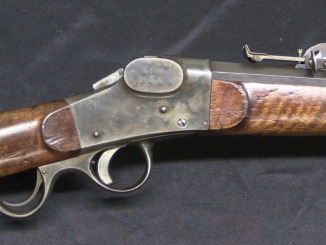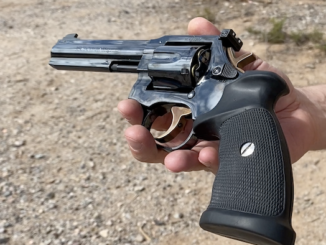The 1880s and 1890s were a fertile period of experimentation with repeating handguns. One such example is this design by Marius Berger, manufactured in France by St Etienne in 1880 and 1881. It uses a ring trigger and a 4-stage cycle in which pulling the trigger sequentially:
1) Opens the breech, extracting the empty case
2) Ejects the empty case as an elevator lifts the next round up from the magazine tube
3) Chambers a new cartridge and closes the breech behind it
4) Fires the cartridge
This particular example, serial number 14, has an interesting and unusual magazine tube design. Instead of removing the follower and loading rounds in the front of the tube, or loading them through the action from the back, this tube has two parts. The inner liner can be rotated to open up the side of the tube, thereby allowing rounds to be dropped in place. The inner tube liner is then rotated back into position, sealing the tube and releasing the follower to push rounds onto the elevator.
Guns like the Berger (and the wide array of Austrian manually-operated pistols of this period) were rendered obsolete as smokeless powder made semiautomatic pistols viable by the mid 1890s. In my opinion, however, they are a really interesting and marvelously varied area of experimentation!
Thanks to the Institute of Military Technology for giving me the opportunity to bring this remarkable pistol to you!




“(…)1880s and 1890s(…)”
U.S. Patent for this weapon: No. 233,466 MAGAZINE FIRE-ARM
https://patents.google.com/patent/US233466
although itself granted in 1880, does mention that covered invention was Patented in France October 28, 1877. thus it might be deduced that inventor was working at it no later than 1870s. Inventor name is given as JEAN MARIUS BERGER.
Thanks for the patent… A repeating rolling block action… Wonder why no auto loading version been made or known…
If you need to automatic pistol with tube magazine then use Swanström 1882 Automatic Pistol https://www.forgottenweapons.com/swanstrom-1882-automatic-pistol/
Thanks… My intention was rather about rolling block…
Sorry, Corey, but a double-action (as opposed to DAO) revolver or semiauto is called that because it has two possible firing modes.
If we were counting operations performed, the revolver would get “credit” for rotating the cylinder, locking it, possibly raising a transfer bar, etc.; the auto even more.
Uhhh… No. The terms “single action” & “double action” refer only to what the trigger does in relation to releasing the firing mechanism, not how many options the user has. A single action trigger performs the sole function of releasing a pre-cocked hammer or striker. A double action trigger performs the dual function of cocking the hammer and releasing it. There is no correlation to other functions that the trigger may perform, such as rotating cylinders, cycling actions, etc.
Firearms that can be used in either mode are properly referred to as DA/SA. If you look at the product page for S&W’s 629 https://www.smith-wesson.com/product/model-629 they list the action as “Single/Double Action”. Given your logic, the term “double action only” would not exist, and a S&W Centennial would be a single action revolver.
The term “Double Action Only” was invented specifically because “Traditional” double action offered both modes; admittedly, that is a relatively recent distinction. “DA/SA” is also a fairly recent term for what were just called “double actions” in the 19th Century.
Yes, that was exactly my point. The curator’s assertion that the Berger is a quadruple or quintuple action because each stroke performs that many ancillary functions makes no sense, because the exact same is true of all existing double-action weapons.
Inventor himself in patent I linked https://patents.google.com/patent/US233466
use term selfcocking.
Daweo,
Makes perfect sense to me!
Nice finish; where are your cotton gloves, Ian???
Jokes aside, what calibre is it? CF or RF?
Sort of like a ring-trigger lever action rolling-block? Or is it?
What is the locking system for the breech-block?
What does the cartridge look like? How long is it and “How many can you get in the tube? Likely only three, hence the weakness of the pistol.
“(…)How many can you get in the tube(…)”
According to http://historypistols.ru/blog/pistolety-pod-unitarnyj-patron-nesamozariydnie/magazinnyj-pistolet-mariusa-bergera-i-ego-raznovidnosti-marius-berger-pistol/ magazine capacity is 5 for full-size model and 4 for short model (see 3rd image from bottom)
Neat
During those old days, any gun for a gentleman on the streets of a city was better than no gun at all. After all, which self-respecting mugger could go to a doctor and get himself treated for 5 lead bullets stuck in his liver without getting asked WHY HE EVEN HAS BULLETS STUCK IN HIS LIVER?
And (as Presidents Garfield and McKinley could tell you) even one or two small-caliber hits in the torso could be fatal, even with the best possible medical care. Muggers and such surely knew this …
Going back a bit farther, the handguns of the American Civil War era were notably low-powered by modern standards, few having more than 200 FPE at the muzzle.
What killed most men shot with them was infections due to dirt, clothing material, etc., driven into the wound. Also, the low-energy projectiles rarely exited; most had to be “removed”, if that was possible. Septicemia and/or peritonitis was the usual result of a torso wound, often within 24 hours.
Most of us today don’t realize what a difference modern antibiotics and even simple sanitary procedures made in survival rates around the turn of the last century.
cheers
eon
“McKinley(…)one or two small-caliber hits in the torso could be fatal”
Wait. So far I know 20th president of United States was killed using .44 caliber British Bulldog https://warisboring.com/the-gun-that-killed-james-garfield/
Do you imply that “.44” is small-caliber by U.S. standards?
is: “(…)McKinley(…)”
should be: “(…)Garfield(…)”
As discussion pertains to European weapon I found it more suitable to bring example from Europe. Bobrikoff was assassinated with 7,65 mm Browning weapon
https://en.wikipedia.org/wiki/Assassination_of_Nikolay_Bobrikov
“in order to murder a prominent official you need not have the organised masses behind you. The recipe for explosives is accessible to all, and a Browning can be obtained anywhere.”
Trotsky knew what he wrote about